Abstract
1. The theoretical effects of demyelination on conduction of a propagated impulse have been examined in a computer simulated myelinated nerve fibre. Demyelination was simulated by increasing the capacitance and conductance of the myelin sheath of individual internodes or parts of internodes.
2. Internodal conduction time increased as myelin thickness was decreased. The increase in internodal conduction time became more precipitous as the myelin became thinner. Propagation continued past a single demyelinated internode until myelin thickness was uniformly reduced to less than 2·7% of normal myelin thickness.
3. Paranodal demyelination was more effective in slowing impulse conduction than was uniform demyelination of an entire internode with an equivalent rise in overall internodal capacitance and conductance.
4. The effects on conduction of demyelination of two adjacent internodes or of two internodes separated by a normal internode were more than the sum of the effects of demyelination of each internode individually.
5. Propagation across a severely demyelinated internode was blocked with an increase in internal sodium concentration which had a trivial effect on conduction in a normal fibre.
6. Propagation across a severely demyelinated internode was blocked with increased temperature at a temperature at which propagation proceeds normally across normal internodes.
7. The similarity between the findings of the computer simulations and the experimental findings in demyelinated fibres is discussed.
Full text
PDF




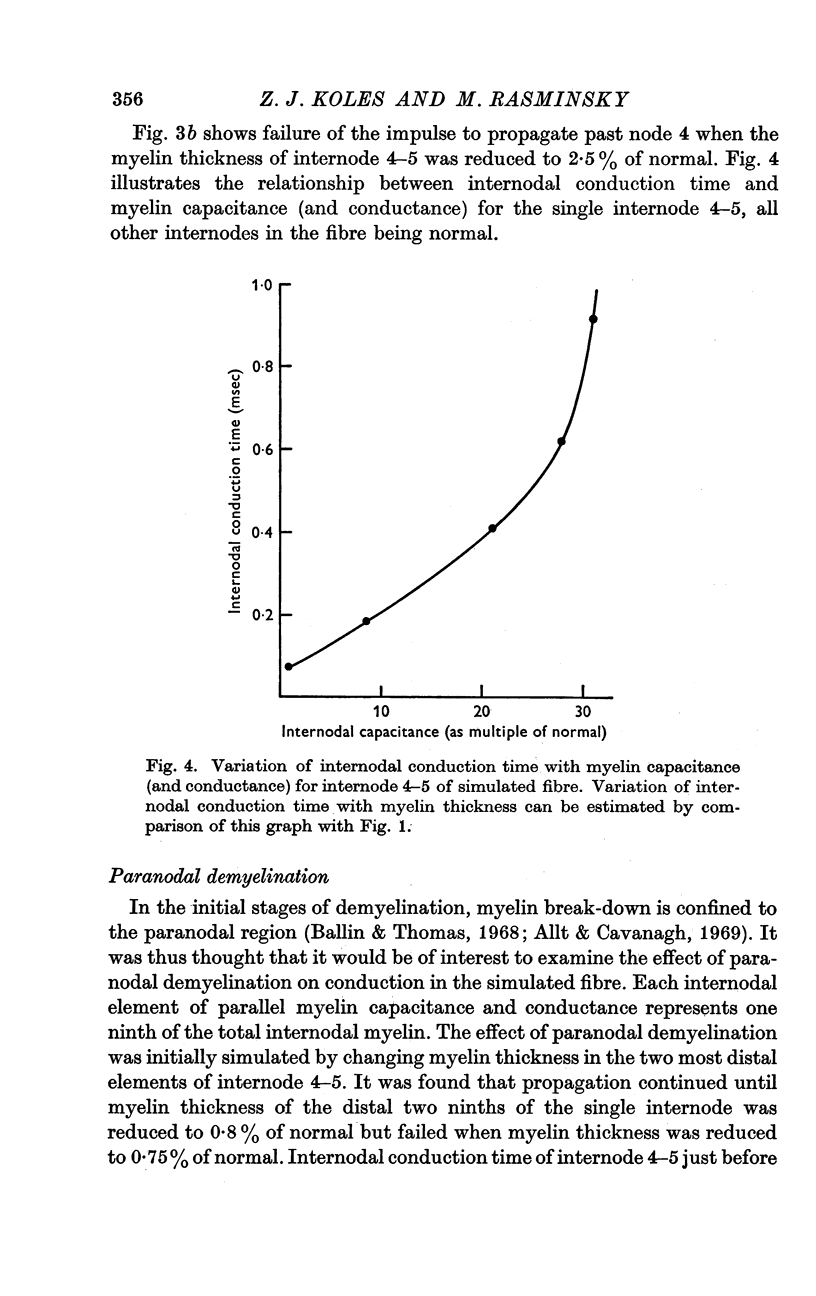


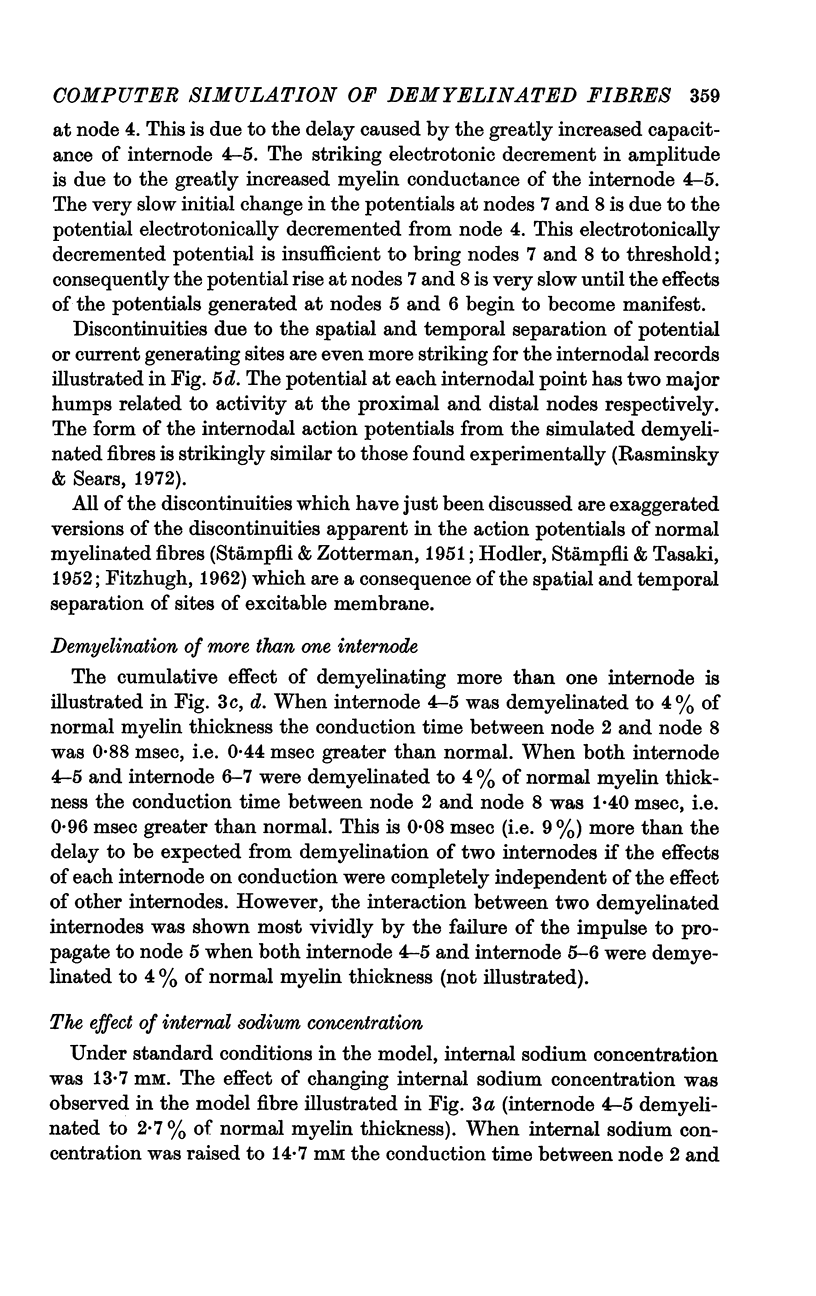
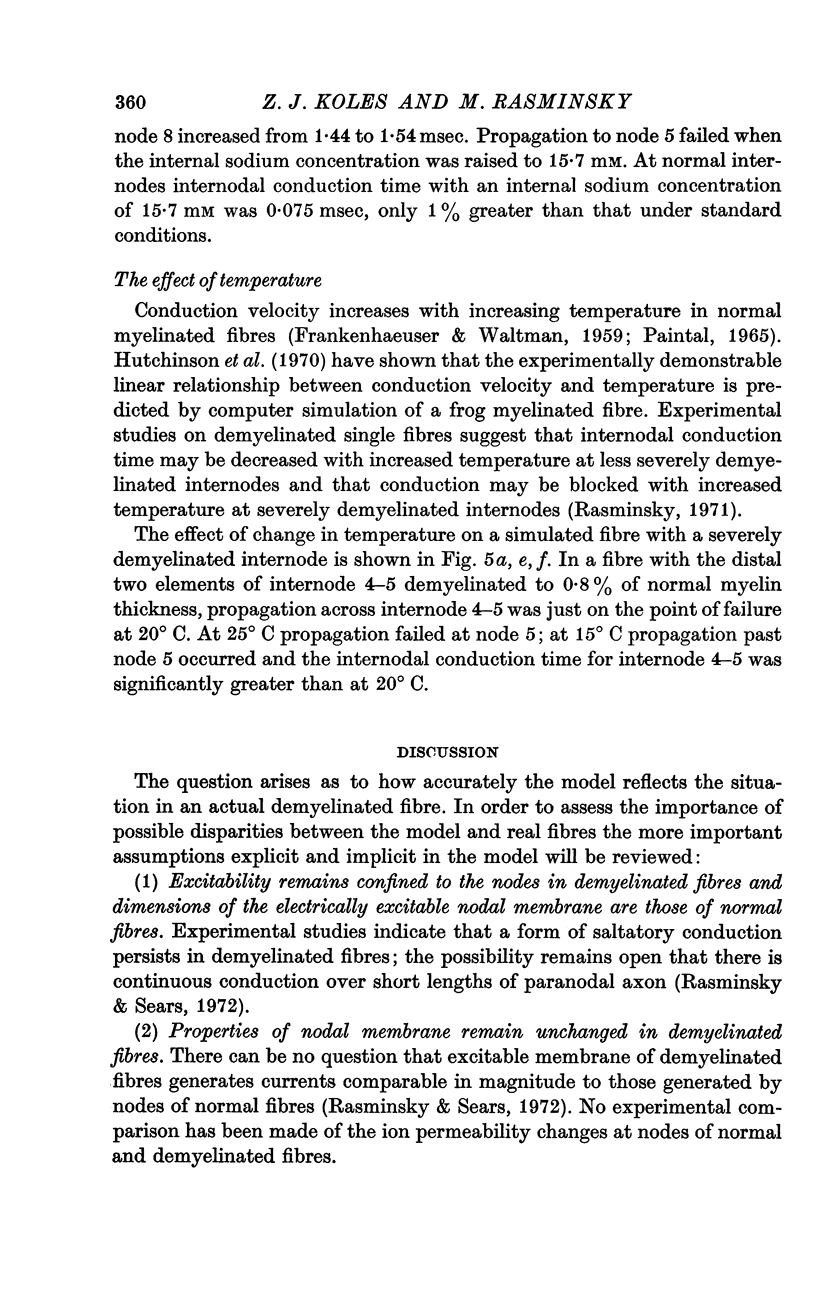

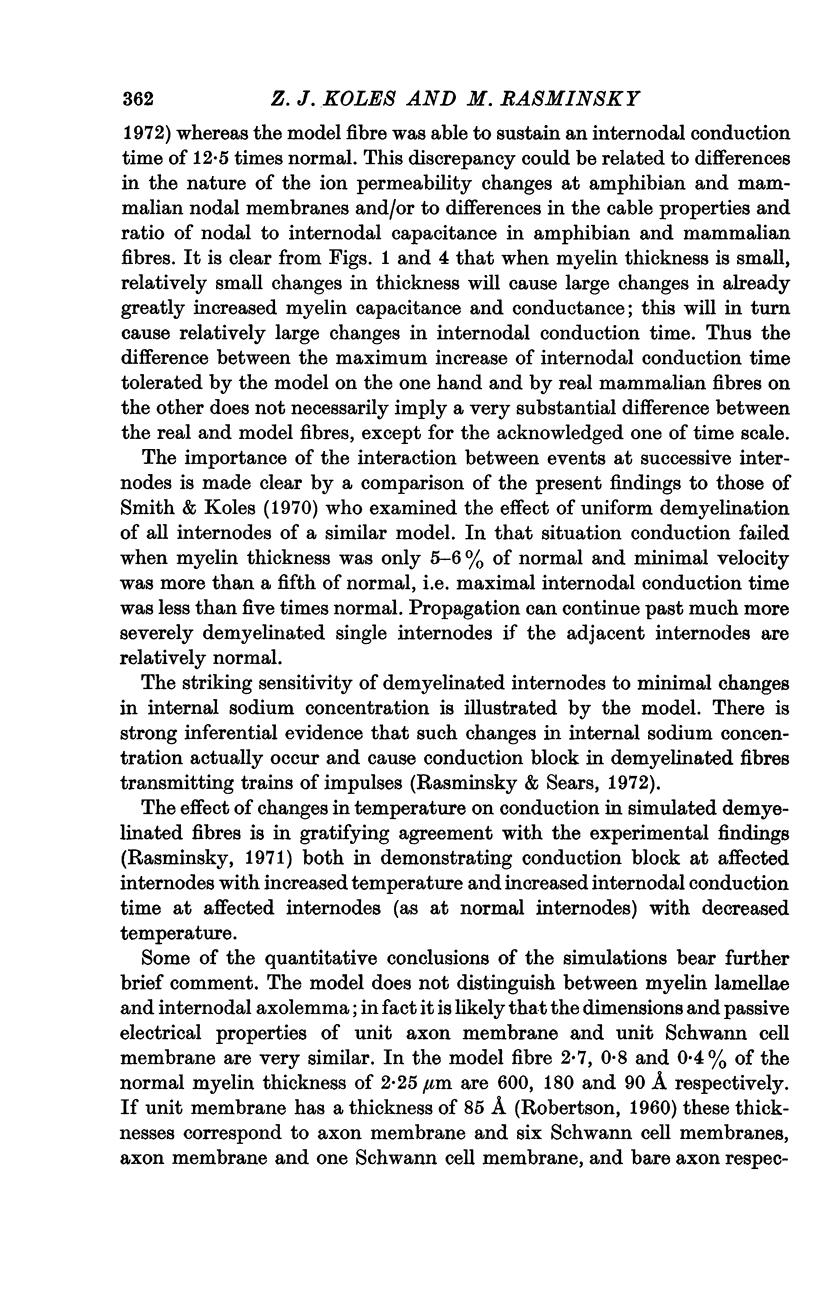
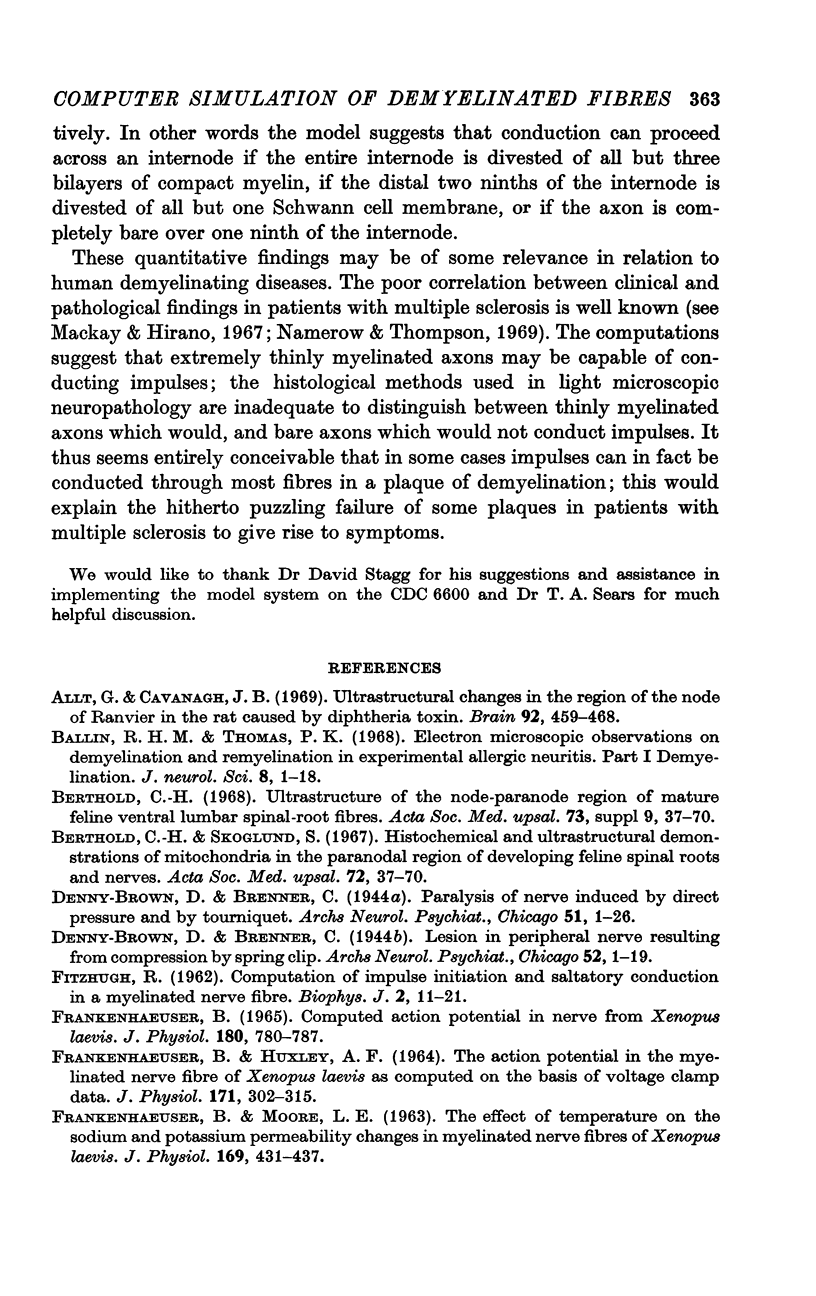
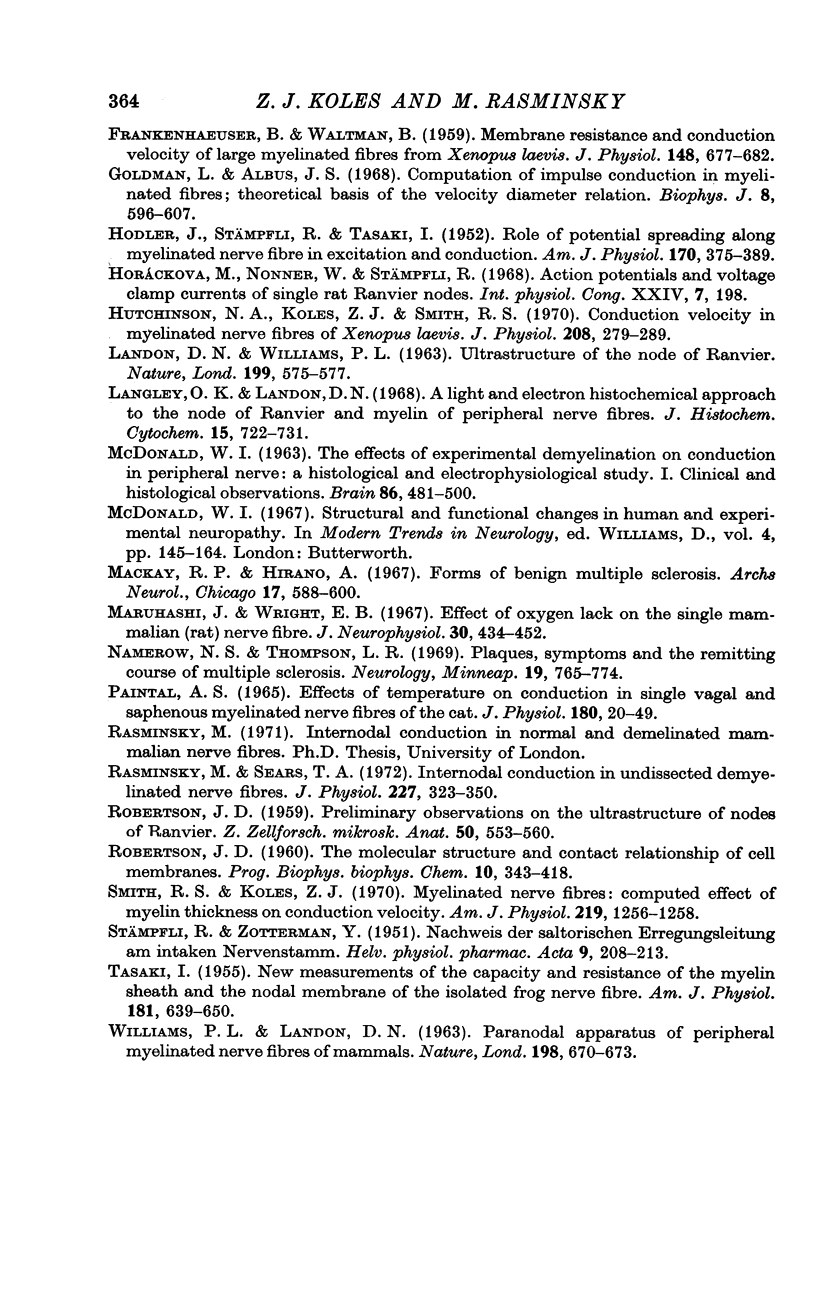
Selected References
These references are in PubMed. This may not be the complete list of references from this article.
- Allt G., Cavanagh J. B. Ultrastructural changes in the region of the node of ranvier in the rat caused by diphtheria toxin. Brain. 1969;92(2):459–468. doi: 10.1093/brain/92.2.459. [DOI] [PubMed] [Google Scholar]
- Ballin R. H., Thomas P. K. Electron microscope observations on demyelination and remyelination in experimental allergic neuritis. I. Demyelination. J Neurol Sci. 1969 Jan-Feb;8(1):1–18. doi: 10.1016/0022-510x(69)90037-9. [DOI] [PubMed] [Google Scholar]
- Berthold C. H., Skoglund S. Histochemical and ultrastructural demonstration of mitochondria in the paranodal region of developing feline spinal roots and nerves. Acta Soc Med Ups. 1967;72(1):37–70. [PubMed] [Google Scholar]
- Berthold C. H. Ultrastructure of the node-paranode region of mature feline ventral lumbar spinal-root fibres. Acta Soc Med Ups. 1968;73(Suppl):37–70. [PubMed] [Google Scholar]
- FITZHUGH R. Computation of impulse initiation and saltatory conduction in a myelinated nerve fiber. Biophys J. 1962 Jan;2:11–21. doi: 10.1016/s0006-3495(62)86837-4. [DOI] [PMC free article] [PubMed] [Google Scholar]
- FRANKENHAEUSER B., HUXLEY A. F. THE ACTION POTENTIAL IN THE MYELINATED NERVE FIBER OF XENOPUS LAEVIS AS COMPUTED ON THE BASIS OF VOLTAGE CLAMP DATA. J Physiol. 1964 Jun;171:302–315. doi: 10.1113/jphysiol.1964.sp007378. [DOI] [PMC free article] [PubMed] [Google Scholar]
- FRANKENHAEUSER B., MOORE L. E. THE EFFECT OF TEMPERATURE ON THE SODIUM AND POTASSIUM PERMEABILITY CHANGES IN MYELINATED NERVE FIBRES OF XENOPUS LAEVIS. J Physiol. 1963 Nov;169:431–437. doi: 10.1113/jphysiol.1963.sp007269. [DOI] [PMC free article] [PubMed] [Google Scholar]
- FRANKENHAEUSER B., WALTMAN B. Membrane resistance and conduction velocity of large myelinated nerve fibres from Xenopus laevis. J Physiol. 1959 Oct;148:677–682. doi: 10.1113/jphysiol.1959.sp006317. [DOI] [PMC free article] [PubMed] [Google Scholar]
- Frankenhaeuser B. Computed action potential in nerve from Xenopus laevis. J Physiol. 1965 Oct;180(4):780–787. doi: 10.1113/jphysiol.1965.sp007731. [DOI] [PMC free article] [PubMed] [Google Scholar]
- Goldman L., Albus J. S. Computation of impulse conduction in myelinated fibers; theoretical basis of the velocity-diameter relation. Biophys J. 1968 May;8(5):596–607. doi: 10.1016/S0006-3495(68)86510-5. [DOI] [PMC free article] [PubMed] [Google Scholar]
- HODLER J., STAMPFLI R., TASAKI I. Role of potential wave spreading along myelinated nerve fiber in exictation and conduction. Am J Physiol. 1952 Aug;170(2):375–389. doi: 10.1152/ajplegacy.1952.170.2.375. [DOI] [PubMed] [Google Scholar]
- Hutchinson N. A., Koles Z. J., Smith R. S. Conduction velocity in myelinated nerve fibres of Xenopus laevis. J Physiol. 1970 Jun;208(2):279–289. doi: 10.1113/jphysiol.1970.sp009119. [DOI] [PMC free article] [PubMed] [Google Scholar]
- LANDON D. N., WILLIAMS P. L. ULTRASTRUCTURE OF THE NODE OF RANVIER. Nature. 1963 Aug 10;199:575–577. doi: 10.1038/199575a0. [DOI] [PubMed] [Google Scholar]
- Langley O. K., Landon D. N. A light and electron histochemical approach to the node of Ranvier and myelin of peripheral nerve fibers. J Histochem Cytochem. 1967 Dec;15(12):722–731. doi: 10.1177/15.12.722. [DOI] [PubMed] [Google Scholar]
- MCDONALD W. I. THE EFFECTS OF EXPERIMENTAL DEMYELINATION ON CONDUCTION IN PERIPHERAL NERVE: A HISTOLOGICAL AND ELECTROPHYSIOLOGICAL STUDY. I. CLINICAL AND HISTOLOGICAL OBSERVATIONS. Brain. 1963 Sep;86:481–500. doi: 10.1093/brain/86.3.481. [DOI] [PubMed] [Google Scholar]
- Mackay R. P., Hirano A. Forms of benign multiple sclerosis. Report of two "clinically silent" cases discovered at autopsy. Arch Neurol. 1967 Dec;17(6):588–600. doi: 10.1001/archneur.1967.00470300030007. [DOI] [PubMed] [Google Scholar]
- Maruhashi J., Wright E. B. Effect of oxygen lack on the single isolated mammalian (rat) nerve fiber. J Neurophysiol. 1967 May;30(3):434–452. doi: 10.1152/jn.1967.30.3.434. [DOI] [PubMed] [Google Scholar]
- McDonald W. I. Structural and functional changes in human and experimental neuropathy. Mod Trends Neurol. 1967;4(0):145–164. [PubMed] [Google Scholar]
- Namerow N. S., Thompson L. R. Plaques, symptoms, and the remitting course of multiple sclerosis. Neurology. 1969 Aug;19(8):765–774. doi: 10.1212/wnl.19.8.765. [DOI] [PubMed] [Google Scholar]
- Paintal A. S. Effects of temperature on conduction in single vagal and saphenous myelinated nerve fibres of the cat. J Physiol. 1965 Sep;180(1):20–49. [PMC free article] [PubMed] [Google Scholar]
- ROBERTSON J. D. The molecular structure and contact relationships of cell membranes. Prog Biophys Mol Biol. 1960;10:343–418. [PubMed] [Google Scholar]
- Rasminsky M., Sears T. A. Internodal conduction in undissected demyelinated nerve fibres. J Physiol. 1972 Dec;227(2):323–350. doi: 10.1113/jphysiol.1972.sp010035. [DOI] [PMC free article] [PubMed] [Google Scholar]
- STAMPFLI R., ZOTTERMAN Y. Nachweis der saltatorischen Erregungsleitung am intakten Nervenstamm. Helv Physiol Pharmacol Acta. 1951 Jun;9(2):208–213. [PubMed] [Google Scholar]
- Smith R. S., Koles Z. J. Myelinated nerve fibers: computed effect of myelin thickness on conduction velocity. Am J Physiol. 1970 Nov;219(5):1256–1258. doi: 10.1152/ajplegacy.1970.219.5.1256. [DOI] [PubMed] [Google Scholar]
- TASAKI I. New measurements of the capacity and the resistance of the myelin sheath and the nodal membrane of the isolated frog nerve fiber. Am J Physiol. 1955 Jun;181(3):639–650. doi: 10.1152/ajplegacy.1955.181.3.639. [DOI] [PubMed] [Google Scholar]
- WILLIAMS P. L., LANDON D. N. Paranodal apparatus of peripheral myelinated nerve fibres of mammals. Nature. 1963 May 18;198:670–673. doi: 10.1038/198670a0. [DOI] [PubMed] [Google Scholar]


